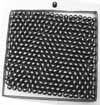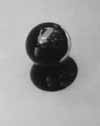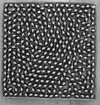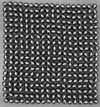Pedagogic Demonstration of the Spontaneously Broken Symmetry
by Magnetic Compasses
to be published in Frontier Perspectives, Vol.10(1)

Yoshihiko Saito1 and Kunio Yasue2
1
Osaka Museum of Science
4-2-1 Nakanoshima, Kita-ku, Osaka 530-0005, Japan
e-mail:saito@sci-museum.kita.osaka.jp
2Research Institute for Informatics and Science
Notre Dame Seishin University
Okayama 700-8516, Japan
e-mail:kunio@ndsu.ac.jp
PACS-1999; 01.50.My, 11.15.Ex, 11.30.Qc, 75.60.Ch
Key wrods
Pedagogic Demonstration, Spontaneously Broken Symmetries, Magnetic Compasses, Nambu-Goldstone boson, magnetic domain
Abstract
A pedagogic daily macroscopic device to demonstrate the spontaneously broken symmetries is developed by which both processes of spontaneous breaking of rotational symmetry and of creating the Nambu-Goldstone bosons can be well illustrated.
One of the most important keywords in modern physics is the spontaneously broken symmetries (SBS). Creation of the universe in cosmology, generation of gauge bosons, Higgs particles, t'Hooft monopoles, instantons and solitons in high energy elementary particle physics, and phenomena of laser, superradiance, superconductivity, superfluidity, phase transition, magnet and electret in condensed matter physics are all well understood in terms of SBS [1]. Those phenomena are all known as order-creating phenomena in nature. Symmetry and order are two mutually complementary concepts: When we have rotational symmetry, there is no particular direction singled out as being different. When we notify a specific direction, there is directional order, and the rotational symmetry should be lost to create such an order.
In the case some external environment of the system imposes certain force to the dynamics of the system, the Hamiltonian governing the dynamics manifests no longer the rotational symmetry, thus realizing the broken symmetries. However, this is quite a natural situation. A remarkable situation is that although the Hamiltonian manifests the rotational symmetry, the ground state can still manifest a directional order. This is SBS. Such an ordered state can be created if the electrons with spin up condense into one of the ground states, and an ordered spatial region is formed spontaneously in which all the spin vectors of the electrons are aligned in one and the same direction. This phenomenon of spontaneously broken rotational symmetry or creation of a spin directional order explains the ferromagnetism; the daily familiar magnetism of magnets made of many internal magnetic domains. As the electron spin can be seen as a magnetic dipole, the system of infinitely many spin vectors is nothing but a system of infinitely many magnetic dipole vectors interacting with each other neighbors via magnetic dipole-dipole couplings.
Also from the technological point of view of modern thin film magnetic devices, a visual real method to illustrate the formation of stable long-range magnetic order in the quasi-two-dimensional systems of magnetic dipoles is needed due to the difficulty in integrating the long-range dipole-dipole interaction in quasi-two-dimensional [2]. Such a real method illustrates the importance of the long-range character of the dipolar interaction in forming and stabilizing the macroscopic domain patterns driven by the spontaneously broken. To accurately model the behavior of an ordered domain with spontaneously broken symmetry, one must take into account not just the nearest-neighbor dipole-dipole forces, but also the longer-range interactions. However, it is quite difficult in practice to compute analytically or numerically these long-range interactions. To overcome these difficulties, a Monte-Carlo type simulation with fast summation and periodic boundary conditions is often used. In our view, however, it is questionable whether these computational approaches are able to reproduce all of the nuances and details, which a real SBS system can exhibit. Our pedagogic demonstration is exactly the real SBS system and suggests many fruitful things as mentioned on this paper.
The mechanism of SBS was first demonstrated theoretically in quantum field theory:[1] In the system of infinitely many degrees of freedom described by the Hamiltonian manifesting the rotational symmetry, only one state is chosen spontaneously among the infinitely degenerate ground states as a real ground state of the system and the rotational symmetry of the system is broken without recourse to any external environment. Although SBS is a mechanism characteristic to the system of infinitely many degrees of freedom described by quantum field theory, it can equally be applied to the system of finite but many degrees of freedom. "Spontaneous" means the following fact: The rotational symmetry is broken not by imposing certain external force, but by the fact that the system itself chooses one and only one ground state among the infinitely many possible ground states and the transition of the chosen ground state into other ones cannot be realized. Due to a simple calculation in quantum field theory [1], the more the degrees of freedom of the system becomes, the more stable the spontaneously chosen ground state is. Thus in the case of infinitely many degrees of freedom, the ground state with SBS becomes highly stable but manifests the broken rotational symmetry. The most familiar example of SBS is the ferromagnetism we already sketched briefly.
In any system with SBS, we expect two features: The first is resulting from the original rotational invariance of the dynamics which implies that the aligned direction of spins can be any direction. Namely, all the ground states with different aligned directions have the same energy, and so infinitely many ground states can exist realizing the infinitely degenerate ground states. The second is resulting from the stability of the ground state with SBS. Suppose that a spin vector in a spatial region of ordered spin vectors in the ground state with SBS happens to deviate from the aligned one and the same direction of spin vectors. In order for the ground state manifesting a directional order to be stable, this deviation of spin direction must be detected by other spin vectors which would then have some means of correcting the wrong direction of the particular spin vector. This requires the presence of certain interaction mechanism among the spin vectors in the region of the ground state with SBS. With such a mechanism any deviation of local spin from the aligned one and the same direction of all the spin vectors can be corrected by the system itself.
This mechanism is provided by a wave that can propagate over the whole of the ordered region of the ground state with SBS. Because the spin vectors in the ordered region are aligned in one and the same direction, a deviation of a spin vector is corrected but overcorrected resulting still in a deviation, thus start oscillating around the aligned direction. Since all the spin vectors are strongly coupled, this oscillation is transferred to all the other spin vectors successively. This is a correlation wave propagating in an infinite range. Existence of such a long-range correlation wave in the ground state with SBS was demonstrated theoretically in quantum field theory, known today as the Nambu-Goldstone theorem [1]. The long-range correlation wave is often called a Nambu-Goldstone mode. A well known example of the Nambu-Goldstone mode is the spin wave or magnon in a ferromagnet.
Although SBS plays the most important role to understand theoretically various order creating phenomena in nature, its concept is highly advanced and requires a mathematical framework of modern quantum field theory such as the Nambu-Goldstone theorem. The absence of an intuitive visual demonstration of SBS has been considered to be a week point of modern advanced framework of quantum field theory. One of the authors (YS) developed a daily macroscopic device to demonstrate SBS and Nambu-Goldstone modes: The device looks simple, consists of 350 ball-shaped magnetic compasses fabricated by Sumitomo Special Metals Co., Ltd., each of which has a plastic rotator containing a ferrite magnet of magnetic flux density 15Gauss at the maximum point on this device floating and confined in oil in a transparent spherical plastic container of diameter 3.0 cm and rotatable freely around the vertical axis. This magnetic compass was designed originally as an automobile accessory, and we marked a visible arrow on the rotator by luminous paint parallel to the magnetic dipole of the ferrite. (Fig. 1).

Fig. 1
Machinery of the device is simple, too. We put the 350 magnetic compasses densely one by one and line by line as a crystal growth onto a rectangle tray obtaining the two-dimensional triangle lattice (Fig. 2),

Fig. 2
, and poured them densely into the tray obtaining the nematic non-lattice structure like the spin glass (Fig. 3).

Fig.3
In both cases of the two-dimensional distribution of 350 magnetic compasses, about 10 to 30 neighboring compasses tend to form an ordered domain in which all the magnetic dipoles point one and the same direction independent to the Earth magnetic field direction. We can see such a typical magnetic domain structure as in the ferromagnetic domain structure in the typical theoretical model of ferromagnetism. In the case of Fig.2, the domain shape and the dipole direction tend to depend on the crystal structure. The domain structure of those 350 magnetic compasses are stable in the sense that we need some considerable vibrational disturbance to the system of magnetic compasses confined on the rectangle tray, thus demonstrating intuitively the role of temperature in the ferromagnetic phase transition. By observing the formation of the ordered domain structure in this device, one can understand visually the essential aspect of SBS without recours to the teary advanced mathematics of quantum field theory.
We put the 350 magnetic compasses also into the strict two-dimensional rectangle lattice, and found no ordered domains just as was predicted theoretically (Fig. 4).

Fig.4
We, however, found that ordered domains are impressed on the case of rectangle lattice if a crystal structure of the magnetic compasses is transformed from the triangle lattice arrangement to the rectangle one by the quasi-static process (Fig.5A, Fig.5B).

Fig.5A

Fig.5B
This is a metastable state familiar in such as supercooling or supersaturation phenomena. The domains go out and never come out, if we vibrate the set of compasses (Fig.5C).

Fig.5C
Furthermore, if one disturbs a magnetic compass in the ordered domain by putting a small magnet closer by hand, propagation of the local directional disturbance to the whole of the ordered domain can be observed. This demonstrates the Nambu-Goldstone theorem, that is, the creation of the long-range correlation wave in the system with SBS. (Since a still picture is not adequate for showing the propagation of the local directional disturbance, that is, the Nambu-Goldstone mode, we prepared a digitized motion picture (700 KB).
To create a successful demonstration of magnetic domain structure, it is not sufficient to merely place many ordinary magnetic compasses in a tray. This is because typical small compasses have a very small magnetic dipole moment, and consequently their mutual magnetic interaction is much smaller than the Earth's ambient magnetic field. Our demonstration solves this problem by using 350 compasses with a very large magnetic dipole moment, to ensure that their mutual interaction is large compared to the Earth's field.
Acknowledgments
The first author (YS) thanks Prof. Takaki Shichiri of Osaka City University and his colleagues in the Osaka Museum of Science for their helpful advice and support. The second author likes to dedicate this note to the late Prof. Hiroomi Umezawa who developed a new world-view based on physics of SBS. This research was partly supported by the Scientific Research Fund of the Ministry of Education, Science, and Culture under grant No.12914022.
References
[1] H. Umezawa, in: Advanced Field Theory - Micro, Macro, and Thermal Physics -, American Institute of Physics, New York, 1993.
[2] K. De'Bell, A. B. Maclsaac, J. P. Whitehead, "Dipolar effects in magnetic thin films and quasi-two dimensional systems" Rev. Mod. Phys. 72,(2000) 225.